MAJOR DENTAL RESTORATION OPTIONS
Custom made crowns and bridges
Precision fit partial dentures and implants
Full restoration of a dental arch on three implants that is not a denture
Special options for patients who can’t have sophisticated dentistry
Custom made crowns and bridges
Precision crown and bridgework begins with a three-dimensional approach–preparing the teeth, gums and bone to create a healthy architecture that corrects the abnormalities. The restorations–both permanent and temporary–must be made according to sound engineering principles that promote health; and they must be comfortable, esthetic and not “fall out”. Crown and bridgework should never have to be “recemented.”
Designing bridgework should include a contingency plan to accommodate any weak areas that could cause future trouble, but very few practitioners are trained to think in this fashion. Sometimes the contingency plan is to make bridgework in two layers. The first layer is a thin protective covering called an underlay coping that seals individual teeth to prevent decay. The second layer is a bridgework overlay. In the event of trouble,
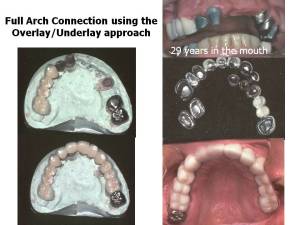 the overlay bridgework can be removed to address a problem. If a fixed bridgework case needs to be converted to a different type of case such as a removable case or an implant case, the underlay copings do not have to be removed. The underlay/overlay approach makes it possible to offer many different restorative options because difficult cases or cases with uncertain outcomes can be managed.
the overlay bridgework can be removed to address a problem. If a fixed bridgework case needs to be converted to a different type of case such as a removable case or an implant case, the underlay copings do not have to be removed. The underlay/overlay approach makes it possible to offer many different restorative options because difficult cases or cases with uncertain outcomes can be managed.
In a weak mouth teeth are often connected or splinted. Connecting teeth helps preserve weak teeth because connected teeth share forces applied to them rather than enduring forces individually. Connecting all the teeth in an arch with one large bridge (called a roundhouse) should never done without the underlay/overlay approach for two reasons: First the degree of precision required for successful crown and bridgework makes it impossible to achieve a true precision fit. There is a big difference between bridgework that actually fits and bridgework that “goes on”. Second, the materials for crown and bridgework are designed for use with small bridges and crowns, not large bridges. These materials must be cast in thicknesses of tenths of millimeters and heated repeatedly at or 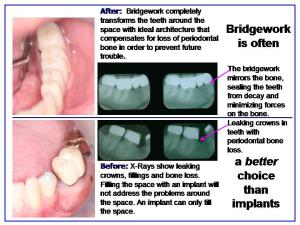 close to their melting points. Dimensional changes are bound to occur and these changes become significant when the materials are stretched beyond what they were designed for. Instead, small bridges and crowns can be connected to form larger sections using the underlay/overlay concept. This approach makes it possible to address sections of a case that require repair, rather than having to remake the entire case if something goes wrong.
close to their melting points. Dimensional changes are bound to occur and these changes become significant when the materials are stretched beyond what they were designed for. Instead, small bridges and crowns can be connected to form larger sections using the underlay/overlay concept. This approach makes it possible to address sections of a case that require repair, rather than having to remake the entire case if something goes wrong.
Careful thought is therefore required when planning crown and bridgework. The piecemeal fill-a-hole-or-a-space approach to dentistry often creates major problems for patients in the long run. The signature of a piecemeal approach to dentistry is the single-tooth implant. While “quick-fix” implant therapy often seems like a great solution, the single tooth implant completely ignores the plight of the teeth that surround it. Fixed bridgework is often a better option because it addresses an entire section of the mouth. Precision fixed bridgework can correct abnormal architecture, create health, compensate for periodontal bone loss and prevent decay across an entire area. A single tooth implant only fills a space.
Precision fit partial dentures and implants
The double-tilt precision attachment case is an ideal option for the patient who cannot have successful fixed bridgework. Often, this option has a more predictable outcome than fixed bridgework and extensive implant surgeries. Very few practitioners in the entire country know how to make a double-tilt precision attachment case. As a result, many practitioner are conditioned t think that fixed bridgework is always the best solution to restorative problem.
This double-tilt precision attachment case has one of the longest track records of any treatment option. It was conceived in 1906 by Herman Chayes and developed in the 1920’s and refined by Dr. I. Franklin Miller more than 70 years ago. Examination and follow-up of cases during a 64 year period at our office overwhelmingly demonstrate that precision 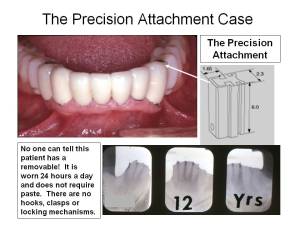 attachment cases offer one of the most successful approaches to restorative therapy. These cases last longer than any other kind of case, including comparable fixed bridgework cases.
attachment cases offer one of the most successful approaches to restorative therapy. These cases last longer than any other kind of case, including comparable fixed bridgework cases.
Retention of the double-tilt partial denture is the result of an unconventional path of insertion and withdrawal. The path is tilted in two directions (hence it is called “double-tilt”) to insure that it cannot come out from the pull of the muscles, the action of the tongue and gravity. When a stress is applied to the partial denture during function, it can move slightly to release the stress, but it cannot be dislodged. As a result, destructive forces are not inflicted on the supporting teeth or implants. Unlike many types of precision attachment partial dentures, it is rare to replace the attachment components even after decades of continuous wear!
The double-tilt precision attachment case offer unique advantages:
1. Superior esthetics: No unsightly hooks or clasps! No one can tell there is a removable!
2. Maintainable periodontal health of the remaining teeth or implants
3. Optimal support for the facial and jaw muscles 24 hours a day
4. Superior comfort and confidence that the removable is not going to come out
5. Superior longevity of the supporting teeth and ridges
6. The ability to retain questionable teeth without compromising the integrity of the case
7. The ability to compensate for changes that occur in the mouth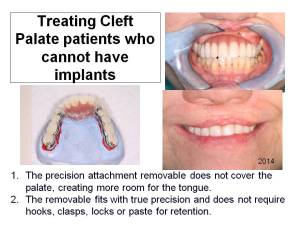
8. No need for replacement of the attachment components
9. No need for the use of denture powder or paste
10. Natural tooth and/or implants can support the partial denture.
The double-tilt precision attachment case is also a great treatment option for cleft palate patients and accident victims who have no front teeth and inadequate bony ridges to support implants. The precision partial dentures are worn 24 hours a day and only removed for hygiene. They are custom designed for maximum esthetics. They do not require denture paste and extend minimally onto the palate. As a result, they do not interfere with the cheek and jaw muscles, tongue movements, speech and taste.
Cleft palate patients and accident victims with poor or non-existent edentulous ridges will have difficulty retaining a denture, so preservation of the existing dentition is essential for their comfort and function. Because the partial dentures do not apply destructive forces to the teeth, they can last decades with minimal maintenance. Fig D
Full restoration of a dental arch on three implants that is not a denture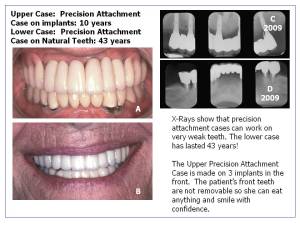
In a quest to make fixed bridgework wherever possible, practitioners commonly stretch the limits of osseointegrated implants. As a result, failures of implant fixed bridgework cases are becoming increasingly more common. Often 5 or more implants are required to restore an arch with fixed bridgework. Many patients do want implants but do not want the extensive cost or bone grafting surgery that may be required for fixed bridgework. The double-tilt precision attachment case–which an amazing track record on weak natural teeth–works exceedingly well on implants, which are strong. We have made these cases on implants for over 23 years.
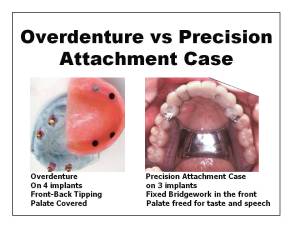 When implants cannot support fixed bridgework in the posterior region, the traditional restorative option offered to patients is the implant-supported overdenture. Some patients undergo the placement for four or more fixtures just to support an overdenture. Although the placement of implants may improve the retention of a denture, patients who choose to go through the surgery, time and expense of implants really yearn to be rid of a denture. Overdentures or removable restorations on implant-supported superstructures may be appropriate when there has been extensive bone and tissue loss in the anterior region of the mouth. In these cases implants may not be able to support the loads applied by the replacement of all the missing structures with fixed bridgework. Most cases, however, do not fit this profile–especially for those with recent loss of teeth.
When implants cannot support fixed bridgework in the posterior region, the traditional restorative option offered to patients is the implant-supported overdenture. Some patients undergo the placement for four or more fixtures just to support an overdenture. Although the placement of implants may improve the retention of a denture, patients who choose to go through the surgery, time and expense of implants really yearn to be rid of a denture. Overdentures or removable restorations on implant-supported superstructures may be appropriate when there has been extensive bone and tissue loss in the anterior region of the mouth. In these cases implants may not be able to support the loads applied by the replacement of all the missing structures with fixed bridgework. Most cases, however, do not fit this profile–especially for those with recent loss of teeth. 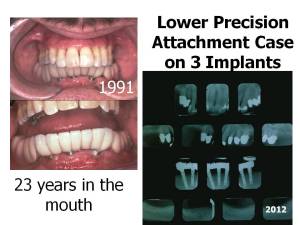
These cases are ideal for lower denture patients. The lower denture is the worst restoration in dentistry because the muscles of the tongue and cheek continually dislodge it. Very few lower denture patients are comfortable as a result. With the placement of only 3 implants, a lower denture patient can restore the entire lower arch, throw away denture powder and paste forever, smile with confidence and acquire the ability to bite into and eat anything.
An implant- supported precision attachment partial denture is superior to an implant-supported overdenture for the following reasons:
1. Superior Comfort and Self-Esteem. There is fixed bridgework in the front of the mouth that does not come out—unlike the overdenture. Patients do not feel old or freakish looking in the mirror when the partial denture is removed for hygiene.
2. Superior Function. Unlike a denture, precision attachment cases are not affected by front/back tipping forces. Patients with implant supported precision attachment cases can bite into anything. An upper precision attachment case also does not cover the palate as do most overdentures.
3. Less Surgery is Required. As few as three implants can restore an entire arch of teeth. The implants are placed in the front of the mouth, avoiding much of the poor anatomy so bone grafts and sinus-lift surgery are rarely needed.
4. Increased Longevity. A precision attachment case does not place lateral forces on implants, which can be destructive to implants as well as to natural teeth.
5. Implant Abutments Can Be Combined with Natural Tooth Abutments. It is not a good idea to make fixed bridgework that connects natural teeth and implants. Natural teeth are connected to the bone by a ligament–a natural suspension system–whereas implants are fused to the bone and do not have any capacity to yield to forces applied to them. The precision attachment case can link natural tooth and implant abutments because there is no rigid connection involved.
Special options for patients who can’t have sophisticated dentistry
Some patients are not candidates for sophisticated dentistry such as crown and bridgework, precision attachment partial dentures or implants. Sometimes the reasons are financial, 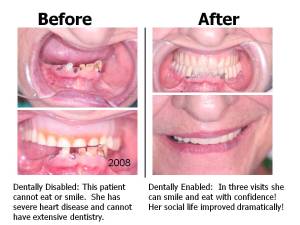 but more often they are for reasons of health. There are patients who cannot handle excessive visits or time in the dental chair. These patients include those who are debilitated with systemic diseases, Alzheimer’s disease or physical ailments. Many of these patients are often turned away from dental offices that do not know how to help them.
but more often they are for reasons of health. There are patients who cannot handle excessive visits or time in the dental chair. These patients include those who are debilitated with systemic diseases, Alzheimer’s disease or physical ailments. Many of these patients are often turned away from dental offices that do not know how to help them.
These patients can often be helped–even on a temporary level–to improve their oral function and quality of life. We often restore teeth and rebuild mouths with temporary restorations made with copper bands. This approach allows us to create temporary restorations that fit like permanent restorations. Like permanent crowns and bridges, these temporary restorations are designed to prevent decay and compensate for periodontal disease. In only a few visits we can completely restore a mouth to ideal function and esthetics. It is extremely rewarding to help patients who have had to endure oral dysfunction, discomfort and social embarrassment.

